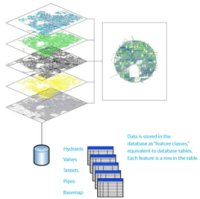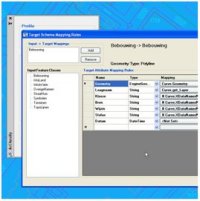The Province of Utrecht has made a big step forward in the direction of comming to a single source of standardized (definitive) CAD-data in an Oracle Spatial enviroment. Main target is the common, organization wide use of data -doesn’t matter if this is admin or geodata.
SDI workflow demo
In my previous post I was talking about a CSWclient prototype. During the Autodesk EMEA GeoSpatial TechCamp2008 in Disneyland Paris, I’ve presented an SDI workflow demo on mainstage.
A city is planning a new housing area and has to extend the existing water, gas and electricity networks.
On the existing basemap they have planned the new houses and streets, and from the utility company they would like to add the existing infrastructure to connect the new utility design.
With the CSWclient they ask the SDI from the utility company about available maps in the area ‘Kouwenhovenselaan’.
The response from the SDI – a list with references to available maps – is used to connect the maps to the AutoCAD Map work-session.
The trenches for the new utilities go to the contractor, who returns an as-built drawing with the exact location after the construction has finished.
On this kind of CAD-drawings the contractor is using texts to mark the used materials and diameters.
It is important to migrate not only the location information, but also materials and diameters into the utility maintenance database.
With a special function in AcClassify it is possible to find texts on a certain layer within a buffer around the lines.
These text values are written as diameter attributes into the database.
working with Features
In the Feature-concept, data will not be stored as CAD-entities ( a line with a linetype on a layer with a color ), but as classified objects. Features are so called Real World Objects; a combination of geometry and attribute-data, like for example roads, parcels, buildings, cables, pipes etc.etc.
 In contrast with previous versions of AutoCAD Map, geometies are no longer imported from SDF, Shape-files or Oracle-tables. We work directly on the files and databasetables in their own native format, without translation by import/export. Multiple users can connect to the same data at the same time, that is a big advantage and solves problems due to copies and different versions floating around.
In contrast with previous versions of AutoCAD Map, geometies are no longer imported from SDF, Shape-files or Oracle-tables. We work directly on the files and databasetables in their own native format, without translation by import/export. Multiple users can connect to the same data at the same time, that is a big advantage and solves problems due to copies and different versions floating around.
Every layer in Map’s Display Manager refers to a single feature-class. These are not the traditional CAD-layers on the AutoCAD way, but “geospatial” layer, to display features thematically and in the proper display order.
Attribute-data or so called properties are part of the feature-definitions. These properties, together with the geometries stored in the same source, can be viewed and directly edited using the Data Table editor. Because we work with connected data, these modifications are directly commited into the source-data.
These attributes can be used as so called labels on the map. No static text, like in CAD, but dynamic labels, positioned by the software in the correct text height and rotation, fit for the scale in which the map is currently displayed.
AcClassify Enterprise
 AcClassify – an AutoCAD Map utility from Autodesk Consulting – developed to leverage expertise around the AutoCAD Map drawing-structure saving this into migration-profiles.
AcClassify – an AutoCAD Map utility from Autodesk Consulting – developed to leverage expertise around the AutoCAD Map drawing-structure saving this into migration-profiles.
Working with AcClassify distinguish the following fases:
Classification-fase
Herewith we define features, how are they represented in the drawing and which specific requirements should they have to become such a feature.
for example the feature “building” consist of lineair objects with the layernamen = “B??_?”
 Mapping-fase
Mapping-fase
Herewith we connect the CAD-properties ( the input ) with the feature-properties in the database ( the output ), optionally “translating” for example colors into diameters.
AcClassify can create the schema-definition of the feature-tables in this fase, or an existing database-schema can be imported.
Migration-fase
In this fase the current drawing will be migrated into the database.
There is also a command to migrate a complete folder of equal drawings with the same migration-profile.
CAD-data => AcClassify => GIS-data
CAD-data is in general structured according to a layer-model, where color, linetypes and blocknames can be used to make more difference.
GIS-data is in general structured according to a feature-model, where objects from the same kind resides in the same feature-table provided with their specific attributes.
 AcClassify – an AutoCAD Map utility from Autodesk Consulting – can filter CAD-data, based on various CAD-properties. AcClassify can “recognize” for example pipes of a certain type. After that AcClassify can migrate those CAD-entities into their corresponding GIS-features and optionally “tanslate” for example color-codes into diameters or linetypes into materials.
AcClassify – an AutoCAD Map utility from Autodesk Consulting – can filter CAD-data, based on various CAD-properties. AcClassify can “recognize” for example pipes of a certain type. After that AcClassify can migrate those CAD-entities into their corresponding GIS-features and optionally “tanslate” for example color-codes into diameters or linetypes into materials.
The major challenge encountered during this process is due to the lack of rigid attribute association with an AutoCAD DWG. AcClassify is designed to collect expertise around these DWG-entities to create a migration-schema which “maps” the unbound attributes to columns in a table, such as found in GIS database-tables.
AcClassify is a modular migration tool which is designed to work on a variety of input sources and output targets. It archives this by de-coupling the input and output phases from the classification engine with modules called adapters, configured in XML-config files.

